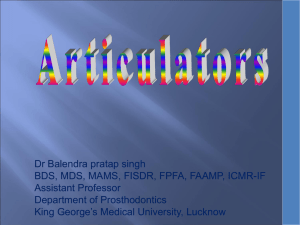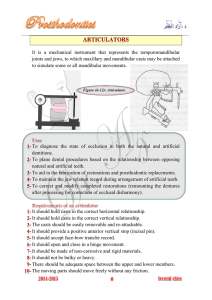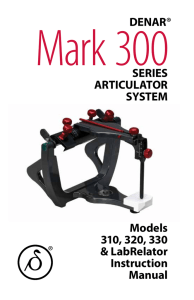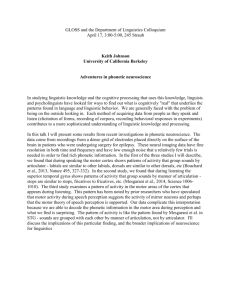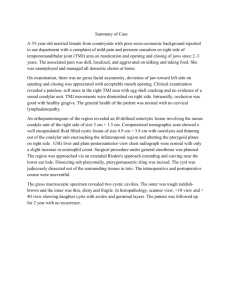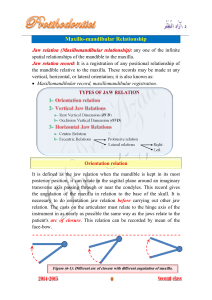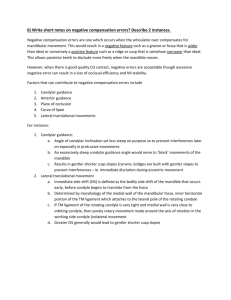ARTICULATOR
advertisement
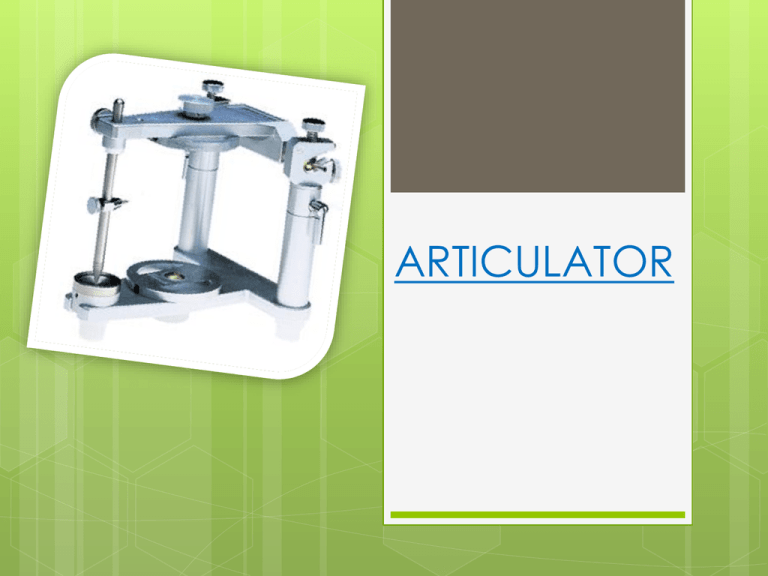
ARTICULATOR DEFINITION Articulator is defined as a “mechanical device which represents the temporomandibular joints and the jaw members to which maxillary and mandibular casts may be attached to simulate jaw movements” GPT Mandibular movements (basic) Excursions of the mandible in 3 directions Downward movementopening of the mouth (20 mm incisor separation-retruded arc of closure) Forward movement-protrusive (20+ & anterior translation of the condyles down the slope of the articular eminence-condylar path) Lateral movements –sideways working side-to witch the mandible moves-immediate shide shift &rotation about vertical axis non working side-condyle moves down and medially, Bennett Angle ELEMENTS OF AN ARTICULATOR horizontal axis of rotation: variability of the position of the horizontal axis of rotation in relationship to the maxillary dental cast condylar inclination/fossa components:variability of the angle of the eminentia, directional guidance of the superior, posterior and medial walls of the fossa, and ability to simuate laterotrusive movement ADJUSTABILITY OF AN ARTICULATOR The capability of the articulator to closely simulate the movements of the mandible (dependent on the adjustability of the articulator elements) PURPOSE OF AN ARTICULATOR To hold the maxillary and mandibular casts in a determined fixed relationship. To simulate the jaw movements like opening and closing. To produce border movements (extreme lateral and protrusive movements) and intraborder movements (within the border movement) of the teeth similar to those in the mouth. USES OF AN ARTICULATOR To diagnose the state of occlusion in both the natural and artificial dentition. To plan dental procedures based on the relationship between opposing natural and artificial teeth eg; evaluation of the possibility of balanced occlusion. To aid in fabrication of restorations and prosthodontic replacement. To correct and modify completed restoration. To arrange artificial teeth. REQUIREMENTS OF AN ARTICULATOR Hold cast in correct horizontal relationship. Hold cast in correct vertical relationship. Should be easily removable and re-attachable. Should provide positive anterior vertical stop (incisal pin). Should open and close in hinge movement. Should be made of non corrosive and and rigid material that resist wear and tear. Should not be bulky. Moving part should move without any kind of friction. Should accept facebow transfer record. Non-moving part should be of rigid construction. ADVANTAGES Properly-mounted casts allow the operator to visualize the patient’s occlusion, especially from the lingual view. Patient cooperation is not a factor when using an articulator once the appropriate interocclusal records are obtained from the patient. Refinement of complete denture occlusion in mouth is extremely difficult because of shifting denture bases and resiliency of the supporting tissue. This difficulty is eliminated when articulators are used. Reduce chair time, patient’s appointment time. LIMITATION Articulator may be made of metal or plastic. Metal articulator show errors in tooling or errors resulting from metal fatigue. The articulator may not exactly simulate the intraborder and functional movements of the mandible. Errors in jaw relation procedures are reproduced as errors in denture occlusion. CLASSIFICATION Based on the theories of occlusion. Based on the type of inter-occlusal records used. Based on the ability to simulate jaw movement. Based on the adjustability of the articulator. ARTICULATOR BASED ON THEORY OF OCCLUSION: BONWILL THEORY ARTICULATORS: Designed by WGA Bonwill. According to the teeth move in relation to each other as guided by the condylar and the incisal guidance. Also known a the Theory of equilateral triangle according to which, the distance between the condyles is equal to the distance between the condyles and the midpoint of the mandibular incisors. Equilateral triangle is formed between the two condyles and the incisal point. BONWILL THEORY ARTICULATORS CONICAL THEORY ARTICULATOR Proposed by RHE HALL It proposed that the lower teeth move over the surfaces of the upper teeth as over the surface of a cone, generating an angle of 45degrees with the central axis of the cone tipped 45 degree to the occlusal plane. SPHERICAL THEORY ARTICULATOR The articulator was devised by G.S Monson. This theory proposed that lower teeth move over the surface of the upper teeth as over a surface of sphere with a diameter of 8 inches. The center of sphere located in the region of glabella. The surface of the sphere passed through the glenoid fossa and along through articulating eminences. BASED ON TYPES OF RECORDS USED FOR THEIR ADJUSTMENT Inter-occlusal record adjustment: articulator adjusted by some kind of inter-occlusal records. These records are made of base plate wax, plaster of Paris, zinc oxide eugenol or cold cure acrylic. Graphic record adjustment: graphic records consist of records of the extreme borders positions of mandibular movements. These are capable of accurately reproducing the border movement of mandible. Hinge axis location for adjusting articulators: a transographic record can be used to record the accurate location of hinge axis in an articulator. Based on ability to simulate jaw movement Class I: simple articulators capable of accepting a single static registration. Only vertical motion possible. Used in cases of tentative jaw relation. E.g. slab articulator, Barndoor articulator. Class II Articulator which permit horizontal and vertical motion but they do not orient the movement to TMJ with a face bow. Three types Type a Type b Type c :limited eccentric motion. E.g. mean value articulator : limited eccentric motion possible based on theories of arbitrary motion. E.g. monsoon’s and hall’s articulator : limited eccentric motion possible based on engraving records obtained from the patient. E.g. house’s articulator Class III Permit horizontal and vertical movements. Two types: Type a Type b they accept a static protrusive registration and they use equivalents for other types of motion eg. Hanau h, hanau II bergstrom articulator. they accept static lateral protrusive registration and they use equivalents for other types of motion, eg. Panadent, trubite, teledyne hanau university series. Class IV Articulator accept three dimensional dynamic registrations. The are capable of accurately reproducing the condylar pathway for each patient. Based on adjustability of the articulator Non-adjustable Semi-adjustable Fully-adjustable Non adjustable They can open and close in a fixed horizontal axis. Have a fixed condylar path along which the condylar ball can be moved to simulate lateral and protrusive jaw movement. Semi adjustable They have adjustable condylar path, adjustable lateral condylar paths, adjustable incisal guide table and adjustable intercondylar distances. Two types: Arcon articulator- Non arcon articulators- •in this the condylar element is attached to the lower member of the articulator and the condylar guidance is attached to the upper member. This articulator resembles tmj. in these, the articulators have the condylar element attached to the lower member. This articulator is reverse of the tmj. SEMI ADJUSTABLE ARTICULATOR ARCON: condylar elements are on the lower member of the articulator, mechanical fossae are placed on the upper member of the articulator NON ARCON: condylar path simulating the glenoid fossae are attached to the lower member, condylar elements are placed on the uper portion of the articulator FULLY ADJUSTABLE ARTICULATOR Capable of being adjusted to follow the mandible movement in all direction. These articulators have a number of readings which can be customized for each patient. They do not have condylar guidance. Instead have receptacles in which acrylic dough can be contoured to form a customized condylar and incisal guidance. E.g. Stuart instrument gnathoscope, simulator by E Granger. MEAN VALUE ARTICULATOR It is non adjustable articulator. Designed using fixed dimensions, which are derived from average distance between the incisal and condylar guidance of the population. Condylar guidance equivalent to glenoid fossa is attached to the lower member and condylar element equivalent to mandibular condyle is attached to the upper member, hence it is a non arcon articulator. Components of articulator Upper Member Lower Member Incisal Guide Table Condylar Guidance Incisal Pin • Upper member It is a triangular frame with the base of the triangle placed posteriorly. The apex of triangle contains a provision to accommodate the incisal pin. Two condylar elements are seen projecting on either side of the base of the triangle. They articulate with the condylar guidance of the lower member. The maxillary cast is attached to the upper member during articulation. • Lower member L shaped frame with horizontal and vertical arm. The horizontal arm is triangular in shape and corresponds to the upper member. The apex of the triangle of the horizontal arm contains the incisal guide table. The vertical arm is rectangular containing the condylar guidance slot at the upper position. Incisal table guide INCISAL GUIDE TABLE It is defined as ‘that part of the articulator which maintains the incisal guide angle’ GPT. The incisal guide table gives the incisal guidance of the articulator. It can be describes as a very short cylindrical whose upper surface is concave. The vertical rod should rest on the center of the incisal guide table during articulation. The incisal guide angle is fixed and non customizable. INCISAL PIN It helps to keep a fixed distance between the upper and lower members at the anterior end. The vertical rod has a pointed tip, which should rest on the center of the incisal guide table during articulation. The tip of the incisal guide pin is the anterior reference point in this articulator. The incisal edge of the maxillary incisors at the midpoint of the occlusal rim should touch the tip of the incisal pin during articulation. NON ADJUSTABLE-SIMPLE HINGE opening and closing around a fixed axis (maximum intercuspation is the only position reproduced) NON ADJUSTABLE Class II: Average value capable for lateral movement, some are cabaple of variable location of the horizontal axis of rotation all of this type have fixed, arbitrary condylar inclination settings, vertical axes of rotation settings, and Benett angle. No adjustment of these elements is available. Some have a provision for incisal guidance. NON ADJUSTABLE-AVERAGE VALUE condylar No adjustment of movements angle relative to occlusal plane in average patient: : 34° Condylus sagittalis Capable for lateral movement, : 15° Condylus lateralis Incisal guidance:10° SEMI ADJUSTABLE • Fully ADJUSTABLE Class III: SEMI ADJUSTABLE simulate lateral, protrusive and Benett movements to varying degrees The amount of adjustability incorporated in the design provides the degree of simulation available. FULLY ADJUSTABLE ARTICULATORS (IV.th year-gnathology)
